The Vonnen Porsche 911 Hybrid Conversion Channels the 911's Future—At a Big Cost
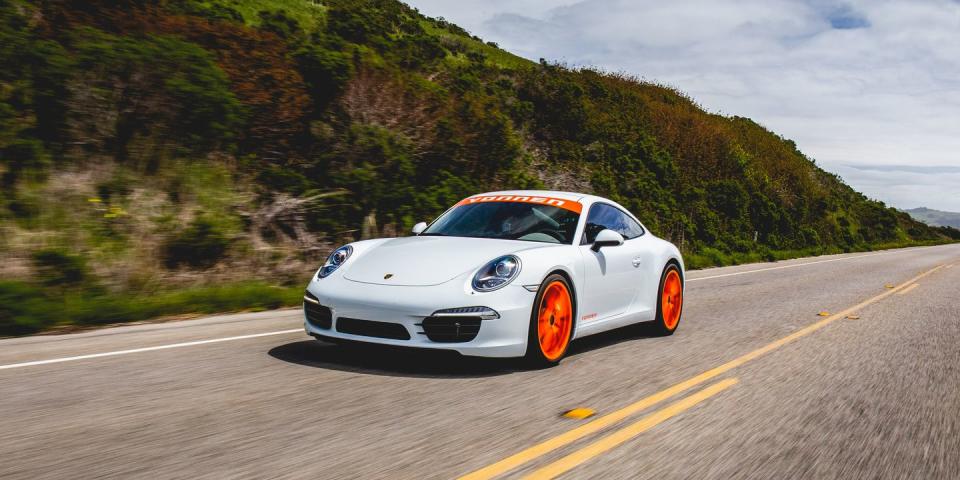
With the knowledge that Porsche has baked a hybrid variant into the product plan of the latest 992-generation Porsche 911, the electrical whine and additional forward thrust produced by this modified 991-era 911 Carrera provides a tantalizing glimpse into the future. This is the effect of the Vonnen Shadow Drive (VSD), an aftermarket hybrid conversion designed by Vonnen Performance that, provided you can justify the not-insignificant cost, integrates a battery and an electric motor into Zuffenhausen's sports car years before the factory gets around to it.
Insert Power Unit Here
The Shadow Drive is a clever setup that adds up to 150 horsepower and 150 lb-ft of torque to the crankshaft of a 911's internal-combustion engine, yet without significantly tampering with Porsche's engine computer nor excessively adding to the car's curb weight. The system itself weighs 210 pounds and includes an electric motor-generator sandwiched between the engine and transaxle; a power inverter mounted on top of the engine; and a control unit and a small 1.0-kWh lithium-based battery pack in the front trunk. However, the net gain is closer to only 170 pounds, thanks to the removal of the engine's flywheel and starter motor, as well as the use of a smaller auxiliary 12-volt battery to power accessories. Given the placement of the motor-generator unit, the system can harvest energy and recharge the battery both from the gasoline engine and during braking.
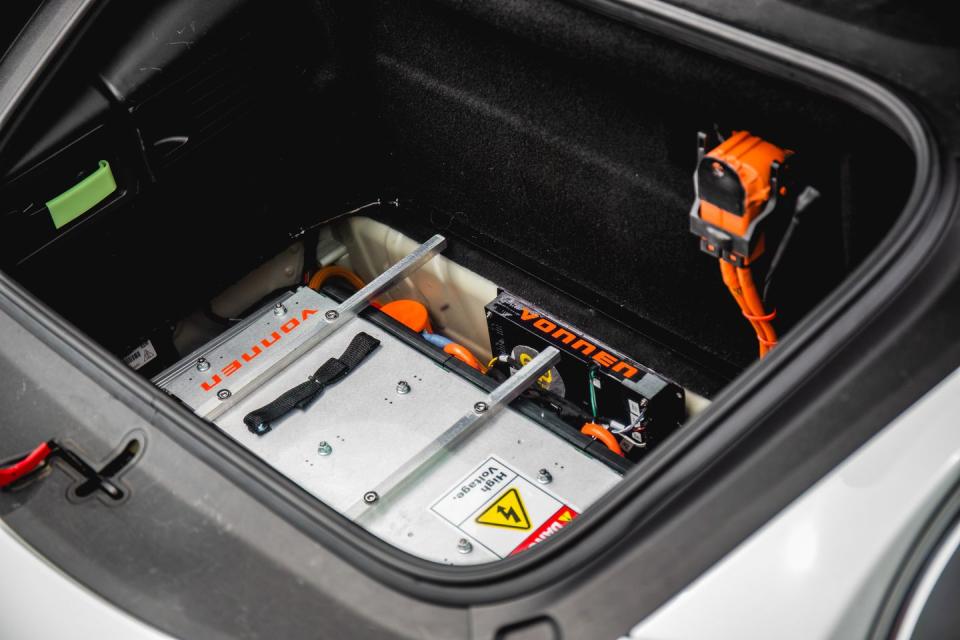
Vonnen president Chuck Moreland says the system's relative simplicity is crucial to maintaining the integrity of the car and its driving experience-a key selling point for Porsche owners. Unlike most hybrid systems, activating the Shadow Drive's electric boost is solely up to the driver's discretion. Accessing the system happens through a Bluetooth-linked smartphone app, which on our test car featured selectable Street, Track, and Overboost drive modes, as well as a switch to shut the system down entirely, returning the car to near-stock form. Also included are real-time system monitoring, data logging, and the ability to share that information with the cloud. In a telling sign that the Santa Clara, California-based Vonnen operates with the quick-shifting mindset of a startup, we're told that the app's Track mode will soon be renamed Sport, and that the configuration of this early interface likely will be revamped in a few months. Even now, final tuning of the drive system itself and how its electrons are delivered are still being tweaked.
Tuning the Thrust
When new, the 2013 911 Carrera that we're driving leveraged 350 horses and 287 lb-ft of torque from its 3.4-liter flat-six, which in our testing was enough to get a similar 2014 model to 60 mph in 4.2 seconds with the standard seven-speed manual. Trim a few tenths from that figure with the optional seven-speed dual-clutch PDK automatic in our hybrid test car, the electronic brain of which Vonnen updates to apply stronger clutch pressure to better manage the increased level of torque. Manual-equipped cars make do with only a mechanical adjustment to the clutch. The Porsche's steering and chassis balance are sublime as we pull off of Pacific Coast Highway and head into the mountains above Malibu, but it’s the VSD's enhanced acceleration we really want to gauge. We start off in Street mode, which Bill Davis-Vonnen's VP of engineering and our co-pilot for the drive-says monitors engine speed and driver inputs to smoothly feed in the electric boost at part throttle. "It feels like you’re basically driving a bigger-engined car.”
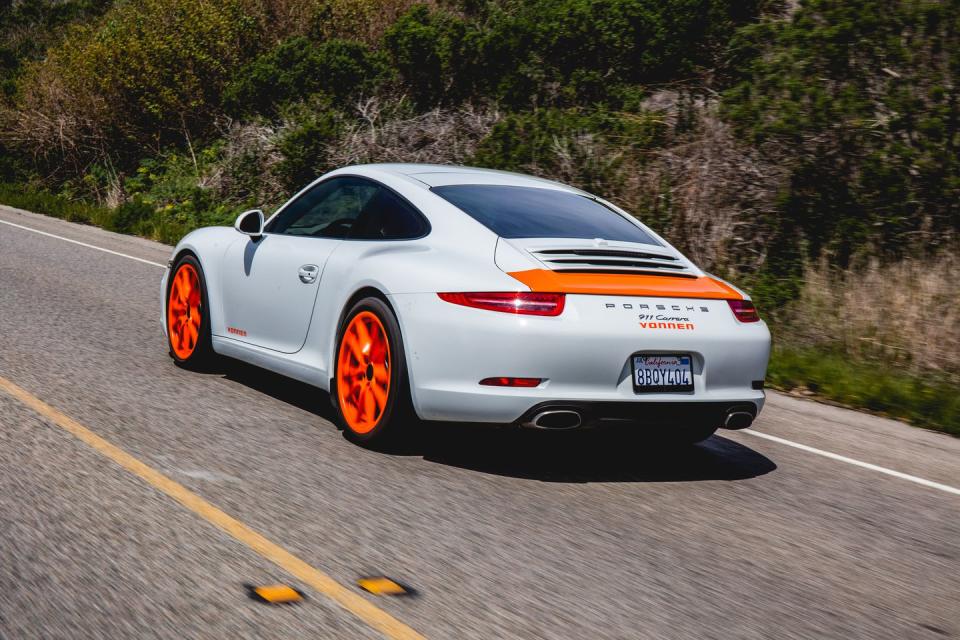
Sport mode is a bit more aggressive in its power delivery, yet, as in the Street setting, it unleashes only 60 to 70 percent of the VSD's potential juice. Launching this hybrid 911 initially feels and sounds the same as when it left the factory, but soon a pronounced electrical whine engulfs the cabin as the electric motor kicks in, accompanied by the sensation of extra thrust as if a pair of turbos have instantly spooled up. It’s here that we hit the system's thermal limit for the first time. Among the smartphone app's displays are a battery charge indicator and temperature readouts for the battery, e-motor, and inverter. The system has a thermal limit of 302 degrees Fahrenheit, beyond which it temporarily shuts down to cool. Depending on how hard you’re driving, this can happen frequently, but the cooling also occurs quickly, often in less than a minute or so. “We’re adjusting the cooling as well," Davis says, "so a production version of this in just a couple of months will be able to be pushed further and recover even more quickly."
Switching to Overboost mode uncorks all of the VSD's power and "turns the dial up to 11," according to Davis. And indeed, objects in our mirrors disappear far more rapidly than before as we're pushed into the 911's seats with noticeably greater force. While we can't fully quantify how much quicker the hybrid car is over stock until we get one to the test track, our calculators say this example likely can eclipse 60 mph in about 3.6 seconds. We wrap up our drive by turning off the system, which helps to recalibrate our senses. When active, the VSD constantly emits a low-frequency electrical whine, which gets louder and more aggressive as acceleration intensifies. With it turned off, the 911 loses much of its newfound drama, the cabin is noticeably quieter, and its acceleration almost seems laggy without the near-instantaneous surge of electric torque.
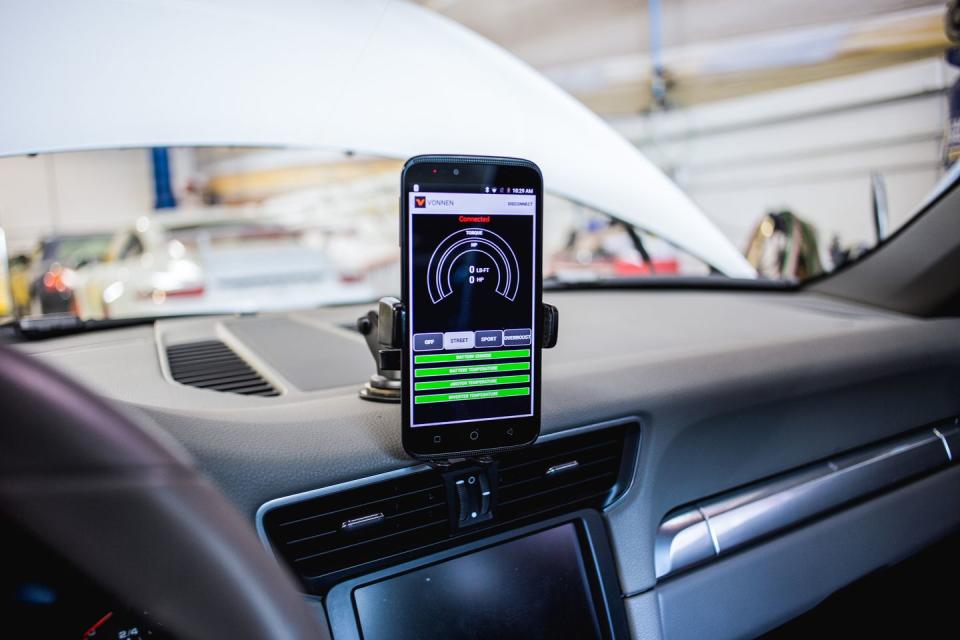
The Catch
The most significant number in the Vonnen Shadow Drive's specifications is its price-$75,000, including installation at Vonnen's shop-which, depending on what corner of the Porsche universe you're coming from, can make a big difference in the conversion's worth. VSD is compatible with both manual and automatic transmissions, as well as naturally aspirated and forced-induction engines, both stock and modified. Initial applications are limited to the 991-series 911 (2012 to 2019 model years), with fitments for the 981-generation Cayman and Boxster available in a couple of months. Compatibility with older 997- and 996-era 911s will follow shortly thereafter, with applications for other Boxster and Cayman models and classic air-cooled 911s coming a few months after that. It’s here where the VSD’s sticker price can perhaps be most justified.
While the Shadow Drive can be seen as a novelty add-on for well-heeled Porschephiles, it is a legitimate performance upgrade ahead of the factory's own development curve. For newer 911 owners merely wanting a boost in power, trading up to a Turbo model would do the job in a significantly simpler and less expensive way. But when considering the less-powerful Boxster and Cayman models, and especially the older 911 generations, the case becomes stronger. "When these cars originally came out, they were fast for their time and had sufficient power," says Vonnen's Moreland. "But those figures look downright slow and weak by today's standards." For an invested enthusiast seeking modern levels of power from a classic 911 without drastically altering the car's simple, air-cooled character-and who is willing to embrace modern technology-the cost of the VSD upgrade might actually make sense.
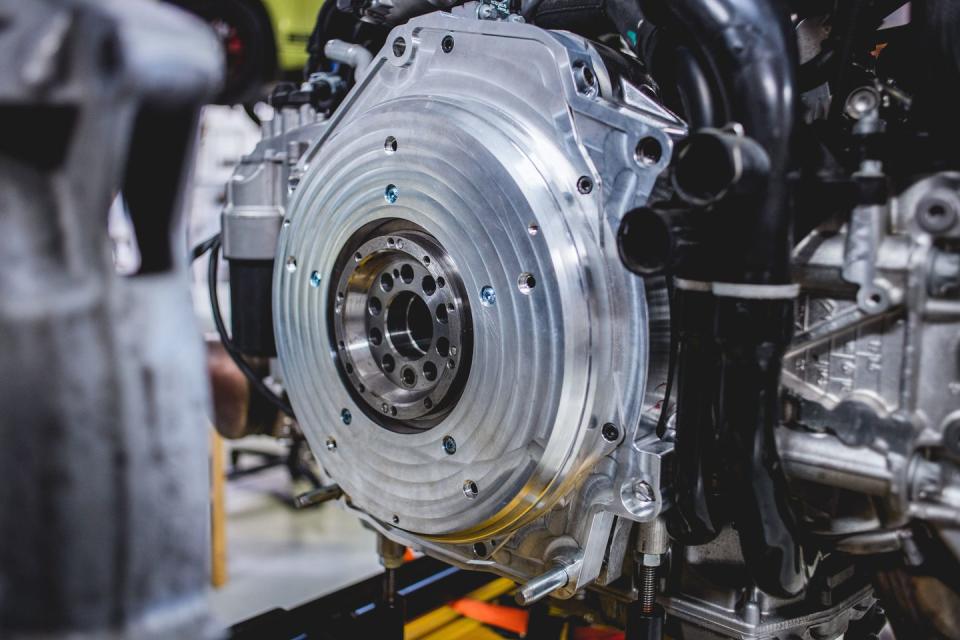
('You Might Also Like',)
